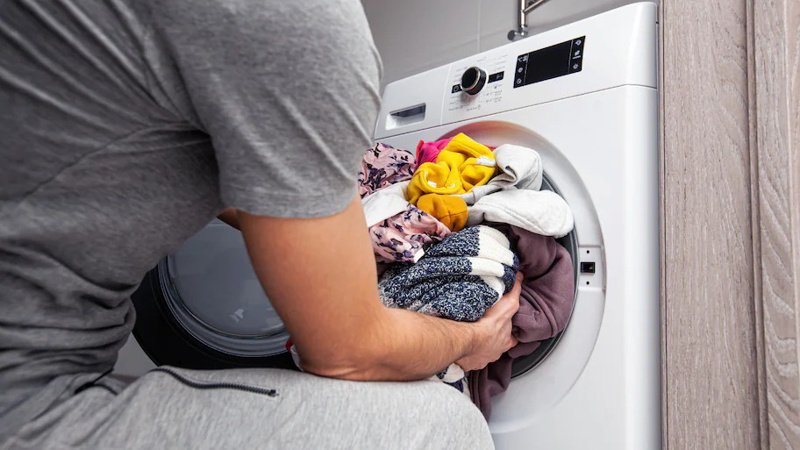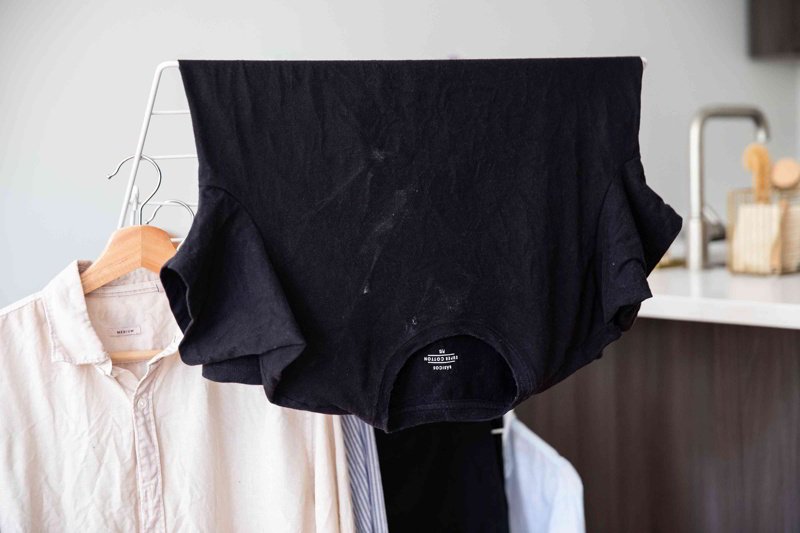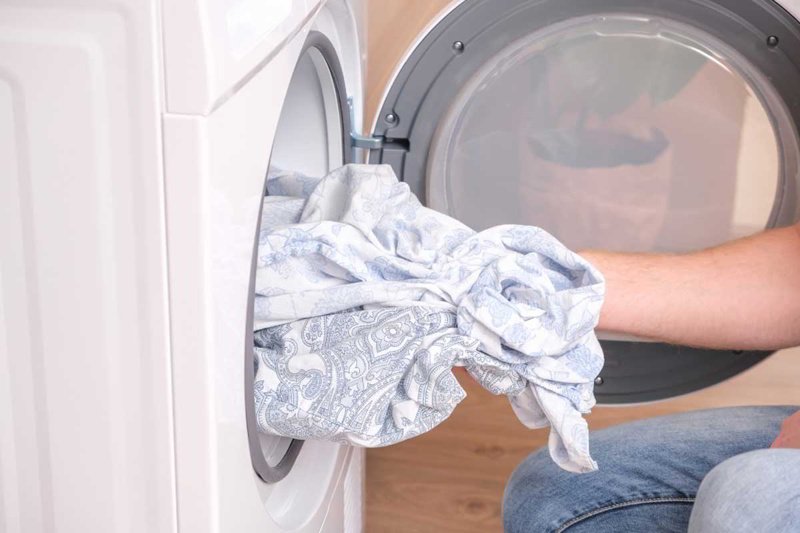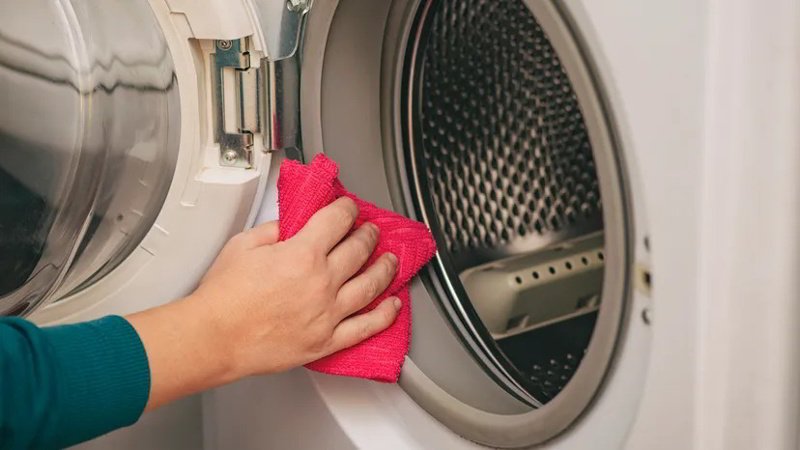White residue on clothes: Causes and how to remove/prevent
Discovering frustrating white residue on clothes after washing is a common headache, particularly for small clothing businesses where inventory quality is paramount. These unexpected marks not only tarnish the appearance of garments but also lead to wasted time, water, and energy spent on rewashing, impacting efficiency and potentially damaging your brand image.
This guide offers valuable insights into why this annoying laundry problem occurs, providing clear, expert-driven steps to remove existing white patches and implement effective strategies to prevent future recurrences. Learn how issues like detergent usage and hard water contribute to the problem and how simple adjustments can ensure your clothing stock remains pristine and ready for customers.
1. Understanding the mystery: Why do white patches appear on laundry?
Finding white residue speckling or streaking across freshly cleaned laundry can be perplexing. This common laundry problem isn’t usually caused by a single factor, but rather a combination of issues related to detergent, water conditions, or the washing process itself. Understanding these potential causes is the first step toward achieving consistently residue-free clothes and maintaining the quality of your garments.
1.1 Too much or the wrong type of laundry detergent
Using an excessive amount of laundry detergent is a frequent contributor to white residue. This is especially true for high-efficiency (HE) washing machines, which are designed to use significantly less water than standard models.
When too much detergent is added, particularly formulations not intended for HE machines (non-HE detergent), there isn’t enough water during the wash and rinse cycles to dissolve and wash away all the suds, leaving behind powdery or streaky marks.
Even with standard washers, exceeding the recommended detergent amount can overwhelm the rinsing process. Always ensure you are using an HE detergent if you have an HE machine, and measure carefully according to load size and soil level, often requiring much less than anticipated – sometimes as little as two teaspoons for HE loads.

1.2 Undissolved detergent dilemmas
Powder detergents are particularly prone to leaving white residue if they don’t dissolve completely during the wash cycle. This issue is more common when using cold water, as lower temperatures significantly reduce the solubility (the ability to dissolve) of powders.
Adding powder detergent directly onto dry clothes before starting the wash can also trap granules within fabric folds, preventing them from dissolving properly in the water. While less common, pouring undiluted liquid detergent directly onto fabrics can sometimes cause blue or greenish streaks, which, although different in color, stems from a similar issue of poor dispersion.
For powder users experiencing residue, especially in cold washes, consider pre-dissolving the powder in a cup of warm water before adding it to the empty washer drum.
1.3 The impact of hard water minerals
Hard water, characterized by high concentrations of dissolved minerals like calcium and magnesium, can react chemically with components found in many soaps and detergents. This reaction forms insoluble precipitates (solids that don’t dissolve in water), commonly known as soap scum.
These mineral deposits cling stubbornly to fabric fibers during the wash and rinse cycles, manifesting as white or sometimes grayish residue after drying. This effect is often more noticeable on dark fabrics due to the higher contrast. If you suspect hard water might be the issue (often indicated by spots on glassware or reduced sudsing), this mineral interaction is a likely cause of the white patches on your laundry.
1.4 Washer overload
While washing full loads seems efficient, cramming too many items into the washing machine severely restricts their ability to move freely. Proper tumbling and agitation are essential for water and detergent to circulate effectively, cleansing the fabric and carrying away soil.
When a washer is overloaded, clothes get packed together, hindering water flow. This prevents adequate washing and, crucially, thorough rinsing. Detergent and loosened soil become trapped within the dense load and can redeposit onto the clothes as white or grayish residue, rather than being flushed away. Ensuring clothes have enough room to move is vital for a clean rinse.
1.5 Fabric softener buildup
Using too much fabric softener, or adding it incorrectly, can also result in residue on clothes. Liquid fabric softeners, in particular, can leave behind a waxy or greasy coating if overused or poured directly onto fabrics without proper dilution or dispensing.
This buildup often appears as white or sometimes bluish streaks or patches, which may feel slightly different (greasier) than typical detergent residue. Correct usage according to product instructions and regular cleaning of dispenser drawers are important to prevent this type of buildup.
1.6 A dirty washing machine
Washing machines require regular cleaning to function optimally. Over time, detergent residue, minerals from hard water (soap scum), lint, fabric fibers, and body soils can accumulate inside the drum, around seals, within pipes, and especially in detergent or softener dispensers.
This gunk provides a source for residue that can loosen during a subsequent wash cycle and redeposit onto supposedly “clean” clothes. If you notice persistent residue despite correct detergent use and loading, or if the machine has an odor, the washer itself might be contributing to the problem.
2. Spotting the signs: Identifying white residue on different fabrics
Recognizing the tell-tale signs of residue is the essential first step before you can address the problem effectively. Knowing what to look for helps distinguish this issue from other potential laundry mishaps.
2.1 Streaks, specks, and stiffness: What to look for
White residue left after washing can manifest in several ways on your clothing:
- Distinct white streaks: These often follow the folds or creases in the fabric where detergent might have concentrated or where water flow was restricted.
- Powdery spots or patches: Small, isolated white specks or larger, more diffused patches that look like talcum powder might be visible, particularly common with undissolved powder detergent.
- General hazy or dull appearance: Especially noticeable on dark or brightly colored garments, the fabric might lose its vibrancy and appear muted or covered in a faint, all-over film.
- Stiff or slightly rough texture: The areas affected by residue might feel stiff, scratchy, or slightly crusty to the touch compared to the rest of the fabric, indicating deposits clinging to the fibers.
2.2 Why dark clothes show residue more clearly
The reason white residue seems to plague dark clothes more than lighter ones is simply a matter of visual contrast. The light color of the detergent or mineral residue stands out sharply against a dark background (like black, navy, or deep reds), making it immediately obvious.
On white or light-colored fabrics, the same amount of residue might be present, but it blends in visually and is much harder to detect. This doesn’t mean the problem isn’t there on lighter clothes, just that darks make it far more apparent.

3. Rescue mission: Step-by-step guide to removing white patches
Don’t despair if your freshly washed clothes emerge with unwanted white marks; removal is usually straightforward, especially if caught early. The approach differs slightly depending on whether the residue is still damp from the wash or has already dried and set. Follow these steps to rescue your garments and restore their clean appearance.
3.1 Immediate action: Treating freshly washed, still-wet clothes
If you notice white residue on clothes immediately after the wash cycle finishes, while they are still wet, act quickly for the easiest removal:
- Keep clothes in the washer: Leave the affected garments inside the washing machine drum. If you’ve already removed them, place them back inside.
- Skip additives: Crucially, do not add any more laundry detergent or fabric softener. Adding more product will only worsen the residue problem.
- Add white vinegar: Pour one cup of distilled white vinegar directly into the washing machine drum with the clothes. Alternatively, you can add it to the fabric softener dispenser, but direct application to the drum is often preferred for this purpose.
- Run a rinse or wash cycle: Select a full wash cycle using cool or warm water (always check garment care labels first for temperature limits). Using an ‘extra rinse’ setting, if available on your machine, can provide additional benefit.
- Mechanism: The mild acidity of the distilled white vinegar works effectively to break down and dissolve both alkaline detergent residue and mineral deposits (soap scum) clinging to the fabric fibers, allowing them to be rinsed away cleanly.
3.2 Tackling dried-on residue: When stains have set
White residue that has dried onto the fabric is more stubborn but can still often be removed with a soak:
- Vinegar soak: This is a good first approach. In a basin, tub, or sink large enough to hold the garments, mix a solution of one part distilled white vinegar to four parts warm water. Ensure there’s enough solution to fully submerge the items. Place the clothes in the solution, making sure the affected areas are saturated, and let them soak for at least one hour. For severe residue, a longer soak may be needed. After soaking, gently rub the residue areas between your fingers or with a soft brush. Finally, launder the items again as usual, but without adding any detergent, to rinse away the vinegar and loosened residue.
- Oxygen bleach soak: If the vinegar soak doesn’t fully remove the residue, or if the residue has a bluish/greenish tint (often from detergent or softener dyes), an oxygen-based bleach soak can be effective. This is generally safe for whites and most colorfast items, but always check garment labels. Carefully follow the product’s instructions for mixing the oxygen bleach powder with the appropriate amount of warm or hot water. Submerge the garments completely and allow them to soak for several hours or even overnight for tough cases. Afterward, rinse the items thoroughly, then launder them again without adding any detergent. Always test for colorfastness on an inconspicuous area if you have any doubts before soaking colored garments.
3.3 What not to do (hint: Avoid the dryer!)
One critical piece of advice: Always inspect clothes for any signs of white residue before putting them into the clothes dryer. The high heat generated by a dryer cycle can effectively bake the detergent or mineral residue into the fabric fibers.
Once heat-set, this residue becomes significantly more difficult, and sometimes impossible, to remove completely. Taking a moment to check items as you transfer them from the washer to the dryer can save you considerable effort later. If you spot residue, treat it using the methods above while the garment is still wet or damp.

4. Prevention is key: Keeping your clothes residue-free long-term
While removing white residue is possible, preventing it from forming in the first place is far more efficient and better for the longevity of your clothing inventory. Consistently applying laundry best practices is the most effective strategy to avoid the frustration of residue-covered garments and ensure your items remain in top condition.
4.1 Mastering detergent use: Amount, type, and adding it correctly
Proper detergent management is fundamental to preventing white residue. Consider these key aspects:
Amount matters: Always use the minimum amount of detergent required to get the load clean. Refer to the detergent packaging and your washing machine manual for guidance, but often, less is more. This is particularly critical for high-efficiency (HE) machines, which use very little water; excess detergent simply won’t rinse out.
Choosing the right type:
- Liquid detergents generally dissolve well in all water temperatures, making them a reliable choice for avoiding residue, especially in cold washes.
- Powder detergents can be cost-effective and work well, but require care, especially in cold water where they may not fully dissolve. Consider pre-dissolving powder in warm water before adding it if cold washing.
- Pods offer pre-measured convenience, but ensure they have enough time and agitation to dissolve completely; place them in the empty drum before adding clothes.
Correct addition: Add detergent to the empty washer drum before loading clothes, or use the machine’s dispenser correctly as specified in the manual. Never pour concentrated liquid detergent or place powder directly onto dry clothes, as this hinders proper dissolving and distribution.
HE compliance: If you own an HE washing machine, exclusively use detergents marked with the HE logo. These are specifically formulated for low-water conditions to rinse cleanly.
4.2 Taming hard water effects
If you operate in an area with hard water (often indicated by spots on clean glassware, bathtub rings, or difficulty getting soap to lather), the minerals present can significantly contribute to residue problems. Addressing hard water can make a substantial difference:
- Water softeners: Installing a whole-house water softening system is the most comprehensive solution, treating all water entering your premises. However, this represents a significant investment.
- Laundry boosters: A more accessible alternative is to add a water-softening laundry booster directly to each wash load. Products like borax or washing soda (sodium carbonate) work by binding with the calcium and magnesium ions, effectively “softening” the water within the wash cycle. This allows the detergent to work more efficiently on cleaning rather than reacting with minerals, thus reducing soap scum formation. Always follow the booster’s package instructions for the correct amount to use per load.
4.3 Smart washing machine habits
How you use and maintain your washing machine plays a vital role in preventing residue:
- Appropriate load size: Avoid the temptation to overload the machine. Clothes need ample space to tumble freely through the water for effective cleaning and, importantly, thorough rinsing. If items are packed too tightly, water flow is restricted, trapping detergent and soil.
- Optimal water temperature: Whenever possible, use the warmest water temperature that is safe for the fabrics being washed (always check garment care labels). Warmer water generally helps detergents dissolve more effectively. If washing in cold water is necessary, ensure the water temperature is ideally above 60°F (15°C), as extremely cold water significantly hinders powder detergent solubility.
- Utilize rinse cycles: If your washing machine offers an ‘extra rinse’ option, consider using it regularly, especially if white residue has been a recurring issue or if you have hard water. The additional rinse helps ensure all traces of detergent and suspended soils are flushed away.
- Regular machine cleaning: Washing machines accumulate buildup over time. Implement a regular cleaning schedule – for example, running an empty cycle with a cup of white vinegar or a dedicated washing machine cleaner tablet monthly (for HE machines) or every few months (for standard machines). Pay special attention to cleaning detergent and fabric softener dispensers, as buildup often occurs there.

5. Addressing specific concerns
While the general principles of preventing white residue apply broadly, certain types of garments or persistent issues may require specific attention and adjustments to your laundry routine.
5.1 Special care for dark and delicate garments
Dark-colored garments are particularly prone to showing white residue due to the high contrast. Therefore, applying preventative measures is especially crucial. Using liquid detergents, which dissolve readily in various water temperatures, is highly recommended.
Measure detergent meticulously, adhering to the ‘less is more’ principle, especially with HE machines. If residue persists, utilizing your machine’s ‘extra rinse’ cycle can provide added assurance that all detergent is removed.
For delicate garments, which are often washed on gentler cycles with less vigorous agitation and potentially less effective rinsing, ensuring the detergent (preferably liquid) is fully dissolved and avoiding overloading the machine becomes even more critical to prevent residue buildup.
5.2 Is my washing machine faulty?
If you consistently find white residue on clothes despite diligently following best practices for detergent use, load size, water temperature, and regular machine cleaning, there might be an underlying mechanical issue with your washing machine.
Persistent residue, especially when accompanied by symptoms like unusually slow water draining after cycles or strange grinding or humming noises during operation, could indicate a problem such as a clogged drain filter or a failing water pump.
These components are responsible for expelling used wash and rinse water; if blocked or malfunctioning, dirty water containing detergent and soil can remain and redeposit onto clothes. Consult your washing machine’s user manual for instructions on locating and cleaning the drain filter (often accessible via a small panel near the bottom front of the machine).
If cleaning the filter doesn’t resolve the slow draining or residue issues, it may be time to consider contacting a qualified appliance repair service for diagnosis.
6. Related questions
6.1 Can using too little detergent cause white residue?
While less common than overuse, using too little detergent can sometimes contribute to residue, particularly under specific conditions like washing heavily soiled loads in very hard water. Insufficient detergent may fail to effectively suspend dirt, grime, and hard water minerals in the wash water.
This allows these particles to settle back onto the fabric surfaces during the wash or rinse cycle, potentially appearing as a dull film or soap scum. However, distinct white streaks or powdery patches are far more frequently caused by using too much detergent or undissolved powder detergent.
6.2 Does the type of fabric affect how likely residue is to appear?
Yes, fabric type can influence both the visibility and likelihood of residue formation. As noted earlier, dark colors show residue most clearly due to contrast. Beyond color, tightly woven synthetic fabrics (like polyester or nylon) might show surface streaks more readily as the residue sits on top rather than being absorbed.
Conversely, highly absorbent natural fibers, such as cotton, particularly in thicker weaves like towels or denim, might be more prone to trapping undissolved powder detergent particles within the fabric structure itself, making them harder to rinse out.
6.3 Are natural/eco-friendly detergents less likely to leave residue?
Not necessarily. Whether a detergent is labeled “natural” or “eco-friendly” doesn’t automatically guarantee it will be less prone to leaving residue. Residue formation depends more on the specific formulation’s effectiveness in your water conditions (hardness) and washing machine, rather than its marketing label.
Some eco-friendly detergents might lack strong chelating agents (chemicals designed to bind hard water minerals) or high-efficiency surfactants (cleaning agents), which could potentially lead to more mineral deposits or soap scum in hard water situations.
Conversely, many high-performance natural or eco-detergents are formulated to work very well and rinse cleanly. Performance varies widely between brands and specific product lines.
6.4 How often should I clean my washing machine to prevent this?
A general guideline is to perform a cleaning cycle monthly for high-efficiency (HE) front-load or top-load washers and perhaps every 2-3 months for older, standard top-loaders that use more water. However, the ideal frequency really depends on several factors: how often you do laundry, the hardness of your water supply, the type of detergent you use (powders and fabric softeners can contribute more to buildup), and whether you frequently wash heavily soiled items.
A practical approach is to clean your machine whenever you notice any musty odors, see visible grime or buildup inside the drum or dispensers, or if you start experiencing recurring residue problems despite using detergent correctly. Regular cleaning helps prevent the accumulation that leads to redeposition.
Read more:
Dealing with white residue on clothing doesn’t have to be a persistent laundry battle. As we’ve explored, those frustrating streaks and patches are typically caused by identifiable factors related to detergent use, hard water minerals, or washing machine habits.
For small clothing businesses, achieving consistently clean and bright laundry is more than just an aesthetic concern; it’s crucial for protecting valuable inventory quality, saving time and resources otherwise spent on rewashing, and upholding a professional image.
Implementing these preventative strategies helps ensure your garments remain residue-free, vibrant, and ready for your customers. Continued attention to these details will contribute significantly to the smooth operation and success of your business.






















